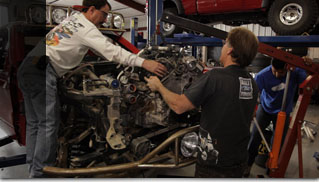 FORD OFFERS UNPRECEDENTED LOOK AT TEARDOWN OF F-150 ECOBOOST ENGINE TO PUBLIC AT 2011 NAIAS
FORD OFFERS UNPRECEDENTED LOOK AT TEARDOWN OF F-150 ECOBOOST ENGINE TO PUBLIC AT 2011 NAIAS
* What: F-150 EcoBoost™ engine teardown. When: Jan. 15, 2011, 11 a.m. Where: North American International Auto Show, Cobo Hall, Detroit; Ford’s Powertrain display
* Teardown free and open to the public
* 2011 Ford F-150 EcoBoost “hero” engine has racked up the equivalent of more than 160,000 miles and 10 years of rugged use
* The 3.5-liter EcoBoost truck engine produces a best-in-class 420 lb.-ft. of torque at 2,500 rpm and 365 horsepower at 5,000 rpm on regular unleaded fuel, enabling best-in-class conventional towing of 11,300 pounds
DEARBORN, Mich., Dec. 27, 2010 – Ford powertrain engineers will tear down an engine that
has gone a distance equal to six times around the earth and three quarters of the way to the moon. Or put another way: the engine has the equivalent of 160,000 miles and 10 years of rugged use. Read more!
Now, Ford engineers want to see how the engine’s parts and components held up. They will disassemble and examine it for long-term durability in front of the public at the North American International Auto Show in Detroit on Jan. 15, 2011 at 11 a.m.
“Customers will be able to see for themselves how the components fared during a regime of tests that, when taken together, are far more extreme than even the harshest-use customer could dish out,” said Jim Mazuchowski, V6 engines programs manager. “This EcoBoost truck engine received no special treatment, and now we’re going to see how it did.”
The F-150 EcoBoost engine saw its first action on the dyno in July. Engineers punished it in temperature and load extremes simulating nearly 10 years of use – a regimen tougher than any consumer could ever subject a truck to. At this point, most engines would be ready to be rebuilt or retired, but the EcoBoost testing engine was just beginning.
The engine was dropped into a regular production 2011 F-150 at Kansas City Assembly Plant Then it hit the road and saw some of the most severe use Ford engineers have ever dreamed up.
* It hauled 55 tons of lumber
* It ran at full throttle for 24 straight hours towing 11,300 pounds
* Beat competitors’ larger engines in an uphill towing competition
* Completed the world’s toughest desert endurance race, the SCORE Tecate Baja 1000 in Mexico
Go to http://www.ford.com/trucks/f150/experiencef150 to see firsthand how the EcoBoost truck engine performs in each of these events.
After its run in the Tecate SCORE Baja 1000, the 3.5-liter EcoBoost truck engine was removed from the F-150 race truck and shipped to Dearborn. To view, go to http://fordvideo.wieck.com/search?q=F-150Baja1000.
Last month, the engine returned to the Dearborn dynamometer lab – where it started its “torture test” – to have power levels and output checked at a speed range from 1,500 rpm to 5,000 rpm. The results:
* Produced best-in-class 420 lb.-ft. of torque at 2,500 rpm on regular fuel
* Produced 365 horsepower at 5,000 rpm on regular fuel
* Power and torque met with the same level of boost as the new advertised power engine
* Cylinder compression (a measure of how efficiently the engine makes power) and leakdown (measures pressure lost due to worn piston rings or defects in the valvetrain) both were still in specification
* No oil or fluid leaks
Twin turbochargers and direct fuel injection
Key to EcoBoost’s performance is the wealth of low-end torque produced by the combination of twin turbochargers and direct fuel injection. Up to 90 percent of the EcoBoost truck engine’s peak, best-in-class torque of 420 lb.-ft. is available from 1,700 rpm to 5,000 rpm – all on regular fuel. The engine produces 365 horsepower at 5,000 rpm.
“Truck customers should think of the EcoBoost truck engine as a gas-powered engine with diesel-type capability and characteristics,” said Mazuchowski. “The twin turbochargers and direct injection give it the broad, flat torque curve that makes towing with a diesel so effortless – and hard acceleration so much fun.”
The EcoBoost truck engine also features twin independent variable camshaft timing, or Ti-VCT, to help save fuel. Ti-VCT provides extremely precise variable – yet independent – control of timing for intake and exhaust valves. Ti-VCT also reduces emissions, especially in situations when the throttle is partially open.
Independent adjustment of intake and exhaust valve timing allows maximum fuel economy at part-throttle, while delivering optimized power in full-throttle situations. An added benefit is improved driveability and responsiveness across the torque curve.
Final phase of EcoBoost “torture test”
The teardown is the final phase of the new 3.5-liter EcoBoost truck engine’s “Torture Test,” a multipart series of web-based documentaries that began when this randomly selected EcoBoost engine endured the equivalent of 150,000 miles or 10 years’ use on the dynamometer, replicating the duty cycle of the harshest-use customer.
EcoBoost is fundamental to Ford’s strategy to provide technologically advanced, high-output, smaller-displacement powertrains that deliver uncompromised performance and fuel economy. EcoBoost engines deliver fuel economy gains of up to 20 percent and reduction of CO2 emissions of up to 15 percent, compared with larger, less-efficient engines.
In addition to turbocharging with direct injection, Ford engineers have enhanced EcoBoost’s technology capabilities by adding variable valve timing and precisely controlling all aspects of the engine. Ford has at least 125 patents on its EcoBoost technology.